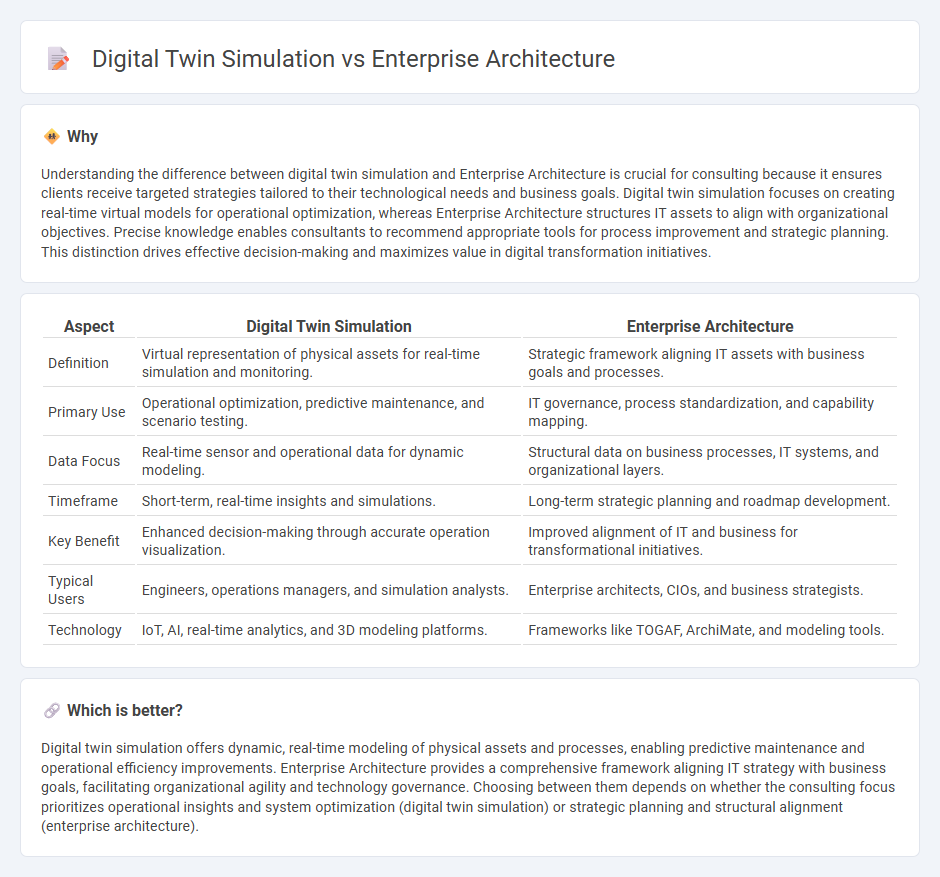
Digital twin simulation creates a real-time, virtual replica of physical assets, enabling dynamic performance monitoring and predictive analysis, while Enterprise Architecture structures organizational IT systems and processes to align technology with business goals. Both methodologies optimize decision-making, but digital twin focuses on operational insights through data simulation, whereas Enterprise Architecture emphasizes strategic planning and system integration. Explore how integrating digital twin simulation with Enterprise Architecture can drive transformative business outcomes.
Why it is important
Understanding the difference between digital twin simulation and Enterprise Architecture is crucial for consulting because it ensures clients receive targeted strategies tailored to their technological needs and business goals. Digital twin simulation focuses on creating real-time virtual models for operational optimization, whereas Enterprise Architecture structures IT assets to align with organizational objectives. Precise knowledge enables consultants to recommend appropriate tools for process improvement and strategic planning. This distinction drives effective decision-making and maximizes value in digital transformation initiatives.
Comparison Table
| Aspect | Digital Twin Simulation | Enterprise Architecture |
|---|---|---|
| Definition | Virtual representation of physical assets for real-time simulation and monitoring. | Strategic framework aligning IT assets with business goals and processes. |
| Primary Use | Operational optimization, predictive maintenance, and scenario testing. | IT governance, process standardization, and capability mapping. |
| Data Focus | Real-time sensor and operational data for dynamic modeling. | Structural data on business processes, IT systems, and organizational layers. |
| Timeframe | Short-term, real-time insights and simulations. | Long-term strategic planning and roadmap development. |
| Key Benefit | Enhanced decision-making through accurate operation visualization. | Improved alignment of IT and business for transformational initiatives. |
| Typical Users | Engineers, operations managers, and simulation analysts. | Enterprise architects, CIOs, and business strategists. |
| Technology | IoT, AI, real-time analytics, and 3D modeling platforms. | Frameworks like TOGAF, ArchiMate, and modeling tools. |
Which is better?
Digital twin simulation offers dynamic, real-time modeling of physical assets and processes, enabling predictive maintenance and operational efficiency improvements. Enterprise Architecture provides a comprehensive framework aligning IT strategy with business goals, facilitating organizational agility and technology governance. Choosing between them depends on whether the consulting focus prioritizes operational insights and system optimization (digital twin simulation) or strategic planning and structural alignment (enterprise architecture).
Connection
Digital twin simulation and Enterprise Architecture are interconnected through their shared goal of optimizing business operations by providing a comprehensive virtual representation of physical assets and processes. Digital twin simulation enables real-time data analysis and scenario testing, while Enterprise Architecture offers a structured framework to align IT infrastructure and business strategy, ensuring cohesive system integration and improved decision-making. This synergy enhances predictive maintenance, resource management, and strategic planning within consulting practices.
Key Terms
Business Capability Mapping
Enterprise Architecture (EA) integrates Business Capability Mapping to align organizational goals with IT infrastructure, fostering strategic development and operational efficiency. Digital twin simulation enhances this by creating dynamic virtual models of business processes to predict performance and optimize decision-making. Explore how combining EA with digital twin simulation revolutionizes business capability analysis and drives innovation.
Virtual Representation
Enterprise architecture provides a structured framework for aligning business processes, IT infrastructure, and organizational goals, ensuring cohesive operational management. Digital twin simulation, on the other hand, offers a dynamic virtual representation of physical assets or systems, enabling real-time monitoring, testing, and predictive analysis. Explore how leveraging virtual representation bridges enterprise architecture with digital twin technology to enhance decision-making and efficiency.
Integration Architecture
Enterprise Architecture (EA) provides a comprehensive framework for aligning business processes and IT systems, ensuring seamless integration across organizational functions through standardized models and governance. Digital twin simulation focuses on creating dynamic virtual replicas of physical assets or processes, enabling real-time monitoring, predictive analysis, and scenario testing within an integration architecture that supports data synchronization and interoperability. Explore how integrating EA with digital twin simulations can optimize operational efficiency and innovation.
Source and External Links
What is enterprise architecture? Definition | MEGA - Enterprise architecture (EA) is a framework that aligns a business's strategy, processes, technology, and information to its goals through four primary layers: business, application, information, and technology architecture, enabling impact analysis, risk management, and improved collaboration between IT and business teams.
Enterprise architecture - Wikipedia - Enterprise architecture is a business function that structures and governs business roles, processes, and data to develop and implement strategy through comprehensive analysis, design, and planning, and is widely used by organizations to improve business performance and guide change.
What is Enterprise Architecture (EA)? - EA is a conceptual blueprint defining how organizations are structured and operate, helping to unify and coordinate processes across departments, align legacy and new systems, and support digital transformation by providing insight into business capabilities and risks.
 dowidth.com
dowidth.com